Moonbuggy
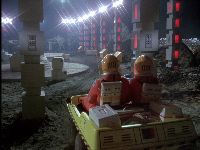
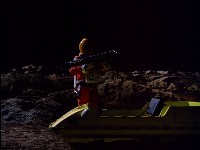
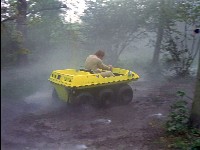

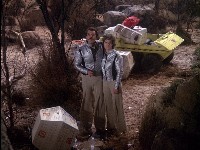
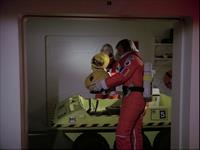
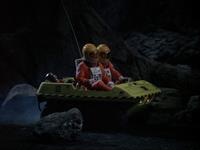
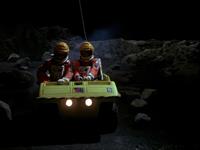
The Moonbuggy is actually an amphibious vehicle called the Amphicat. It is also well known for its appearance in the American children's show Banana Splits (1968-1970).
The vehicle is constructed from a two-piece ABS plastic moulded body shell. It was made in the late 1960s and early 1970s by two companies- Behoo Industries in Ontario, Canada, and Mobility Unlimited/Magna American in the USA. The Space 1999 model is the Canadian version, with the exhaust on the right hand side.
Small all-terrain vehicles became popular in the 1960s, the first being Canada's Jiger in 1961. Beehoo and Mobility's Amphicat being the most popular all terrain vehicle. The 1973 oil crisis killed the market, and consumers then turned to cheap and reliable 3 wheel and quad bikes by Honda, Suzuki and other Japanese manufacturers. Several companies still produce 4 and 6 wheel all terrain vehicles, including Argo of Canada, which designed the transmission for Beehoo's Amphicat in 1962, and produced their own vehicles from 1967.
Canadian engineer Ron Beehoo developed the original "Aquacat" amphibious all-terrain vehicle, and founded his company, Beehoo Industries of Ontario to build it, soon renamed the "Amphicat". The vehicle used two revolutionary innovations in the 1960s that made all-terrain vehicles light, cheap and robust.
In 1966, Beehoo Industries sold the US distribution rights to Mobility Unlimited of Michigan, with Beehoo retaining Canadian and world export markets. Unable to satisfy US demand, Mobility Unlimited and Beehoo sold US manufacturing rights by Magna American of Mississippi (who would take over Mobility Unlimited in 1970).
Keith Wilson obtained the vehicle from Crayford Special Equipment Ltd of Westerham, Kent; the electric start models were priced at £895. In the photo below of Keith Wilson and Michael Ford, in Year 2 around the filming of The Taybor, a publicity brochure and the "owner workshop manual" is pinned to the wall behind Michael, with the dealer name visible.
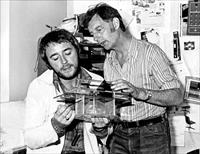

Like all Amphicats, the original colour was red, but it was painted yellow for the start of the series. Decoration included the "spectrum" Moonbase insignia on the front, back and sides. Panel lines and a small number "8" label on either side. The detailing changes through the series:
See Moonbuggy in 2022 for a detailed history of the prop since the series.
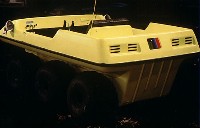


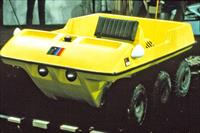

These rare photos show the vehicle shortly before filming Breakaway. Black and yellow striped edging would be added, and black panel lines to the sides and front. Thanks to Mark Shaw.






Slightly different versions of one of the above pictures, in black and white with better definition, alongside the buggy as it finally appeared in Breakaway, with panel lines and striped lines.
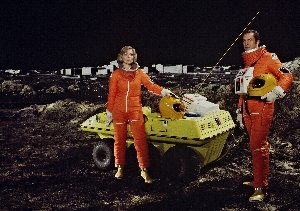
The moonbuggy early in the series. Note the hose from the exhaust at the back, leading under the vehicle. More pictures
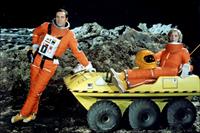
There is a little badge on each side in front of the wing mirrors, with the spectrum also seen on the front and back, and the letters "MBA".
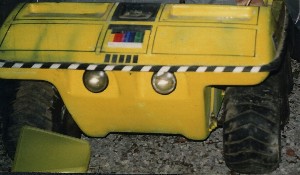
For many years the original Space 1999 moonbuggy was on display at the Blackpool Space City exhibition and later at Alton Towers in the UK. These pictures were taken shortly after Alton Towers. It was owned by the Cars Of The Stars museum in Cumbria, although it was not on display. It was later sold to an Italian fan.

The vehicle is actually red (see the engine photo below for the original colour). For Space 1999 the vehicle was painted yellow. The detailing changed several times during the series; the number "5" was acquired for Space Warp and The Bringers Of Wonder part 2.
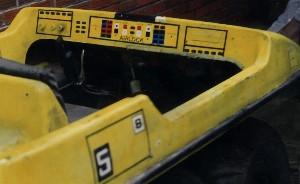
The only real controls are the three yellow knobs left, and the two control sticks. The control sticks control each side of the vehicle (you turn by moving one stick forward and the other back). The coloured controls here are all fake. At the start of the series, there are no fake controls, but by Space Warp and The Bringers Of Wonder part 2 various labels were added. The model was redecorated for the Space City exhibition; notably the area around the petrol tank cap on the front is painted with a black stripe, and new "Airlock" dashboard controls were added.

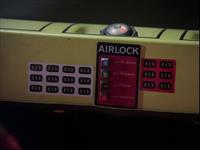
The labels in Space Warp are different from those on the vehicle now. Originally there were no labels on the dashboard.
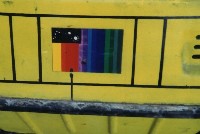

Compare the space crest on the back of the moonbuggy with the woven badge used on the spacesuits. In Year 1, the spectrum crest looked like the spacesuit crest, with greens left, blues in the centre and reds and yellow on the right. In Year 2, the colours swapped to the opposite sides, as shown here.
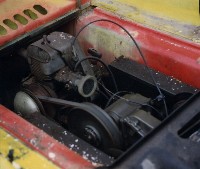
The petrol engine. The 16hp Sachs air-cooled engine drives all six wheels through live axles. These small Wankel engines were introduced in the 1960s. Top speed is 15.6 km/h (35 mph). It has a water speed of up to 3 km/h (1-2 mph), or 2.24km/h (5 mph) if an outboard motor is fitted. The Amphicat can carry up to 217.7 kg / 480 lb. It can turn within its own length (2.06m; 6 feet 9 inches) and negotiate gradients of 45 degrees.
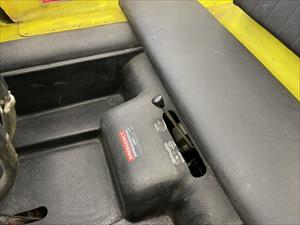

Details of the driving controls. See driving page for how these really work
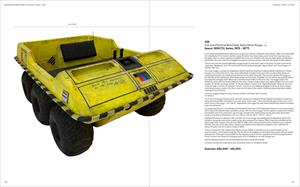

On 3rd November 2022, the Moonbuggy was put into auction (PropStore auction listing. The estimate was £80,000 - £120,000. The original 1973 price of £895 with inflation until 2022 would be £8,675. It did not reach the reserve, and was not sold.
Images copyright Martin Willey except for Space 1999 images (copyright ITV Studios Global Entertainment)
Page copyright Martin Willey